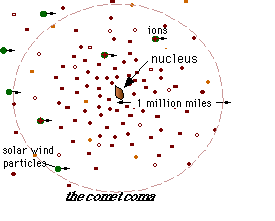This image is a schematic of a comet. The center part of the comet, or nucleus, is represented by the flame. The solar wind particles are shown as green dots with arrows. And the ionized particles are shown as green/red dots with arrows. Neutral particles are shown by the other dots (without arrows).
Click on image for full size
JPL
The Comet Coma
As the ices of the comet nucleus
evaporate, they expand into a large cloud around the middle part of the comet.
This cloud, called the coma, is the atmosphere of the comet. It can extend for millions of miles. The cloud is very thin, 10,000 times thinner than a cloud in the Earth's atmosphere!
You might also be interested in:

When evaporation begins, the gas is propelled from the nucleus at supersonic speed (depicted by arrows in the figure). Because of the low gravity in space, this means that the molecules from the nucleus
...more
When comets are kicked out of the Oort Cloud, they begin a passage into the solar system, spinning and tumbling as they come. As the comet comes closer to the sun, near the region of space occupied by
...more
Comet Wild 2 is named after the scientist who discovered it. Paul Wild is an astronomer from Switzerland who discovered the comet in January 1978. Wild 2 is pronounced "Vilt 2". It takes the comet a little
...more
Stardust is the name of a space mission that studied a comet. Stardust flew very close to the comet in January 2004. It took some very good pictures of the nucleus of the comet. It also grabbed some dust
...more
The pictures on this page show the nucleus of a comet. These are the best pictures ever made of the nucleus of a comet. The nucleus of a comet is a big lump of ice and dust. This one is about five kilometers
...more
Scientists have found a type of amino acid in a sample returned from a comet. Amino acids are the building-blocks of proteins. Proteins are one of the most important types of molecules in living creatures.
...more
Comet Hale-Bopp was one of the brightest comets of all time. Astronomers witnessed the comet spew out intermittent bursts of dust. The surface seemed to be an incredibly dynamic place, with 'vents' being
...more















